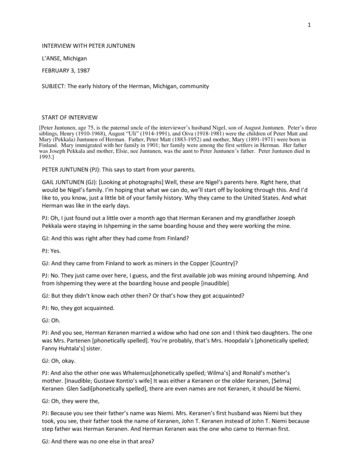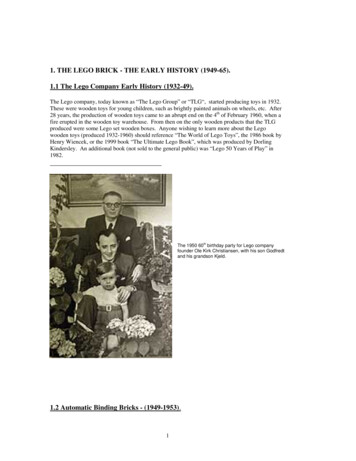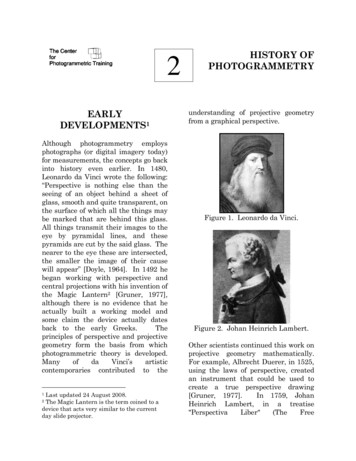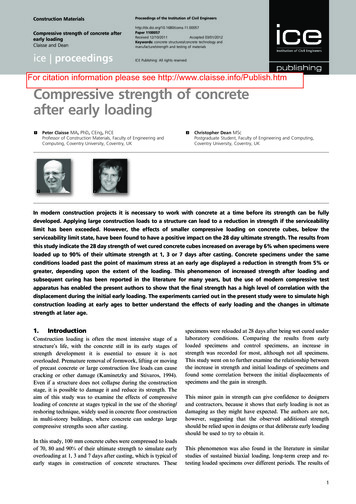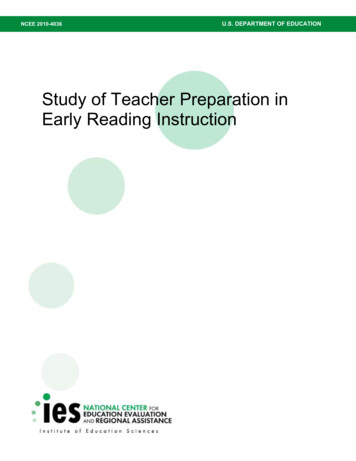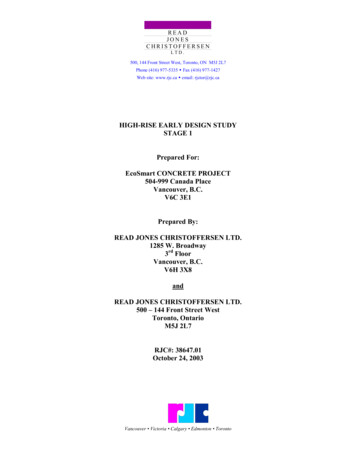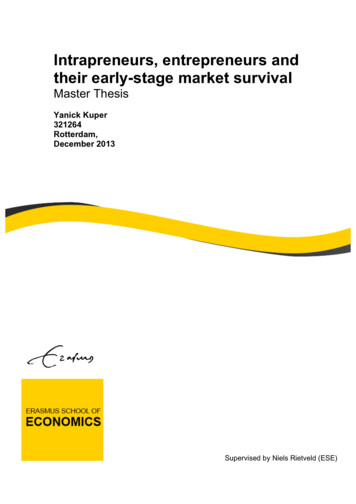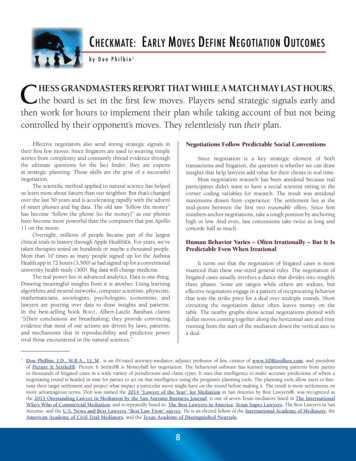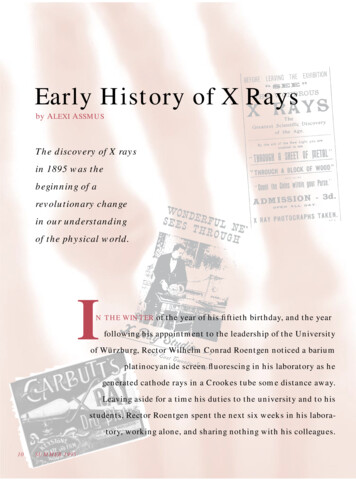
Transcription
Early History of X Raysby ALEXI ASSMUSThe discovery of X raysin 1895 was thebeginning of arevolutionary changein our understandingof the physical world.IN THE WINTER of the year of his fiftieth birthday, and the yearfollowing his appointment to the leadership of the Universityof Würzburg, Rector Wilhelm Conrad Roentgen noticed a bariumplatinocyanide screen fluorescing in his laboratory as hegenerated cathode rays in a Crookes tube some distance away.Leaving aside for a time his duties to the university and to hisstudents, Rector Roentgen spent the next six weeks in his laboratory, working alone, and sharing nothing with his colleagues.10SUMMER 1995
Wilhelm Conrad Roentgen (1845–1923).(Courtesy of AIP Emilio Segré VisualArchives)that jolted the finde-siècle discipline out of itsmood of finality,of closing downthe books withever more precisemeasurements, oflosing itself in debates over statisticalmechanics, or of trying to ground allphysical phenomena inmathematically precisefluctuations of the ether.All three discoveries, X rays,uranium rays, and the electron, followed from one of themajor experimental traditions in thesecond half of the nineteenthcentury, the study of the dischargeof electricity in gases. All threecontributed to a profound transformation of physics. In the 20th century, the discipline has been grounded in the study of elementaryparticles.As with the invention of incandescent lightbulbs, the studyof electrical discharge throughgases was madepossible by thedevelopment ofimproved vacuum technologyin the 1850s. Early on, Englishscientists wereinvestigating thepatterns of lightand dark that appeared in sealedlead-glass tubes.The patterns inForms of tube used by Roentgenin 1895–1896 for the productionof X rays.German Museum, MunichThree days before Christmas hebrought his wife into his laboratory, and they emerged with a photograph of the bones in her hand and ofthe ring on her finger. The WürzburgPhysico-Medical Society was the firstto hear of the new rays that couldpenetrate the body and photographits bones. Roentgen delivered thenews on the 28th of December 1895.Emil Warburg relayed it to the BerlinPhysical Society on the 4th of January. The next day the Wiener Presscarried the news, and the day following word of Roentgen’s discoverybegan to spread by telegraph aroundthe world.On the 13th of January, Roentgenpresented himself to the Kaiser andwas awarded the Prussian Order ofthe Crown, Second Class. And on the16th of January the The New-YorkTimes announced the discovery asa new form of photography, whichrevealed hidden solids, penetratedwood, paper, and flesh, and exposedthe bones of the human frame. “Menof science in this city are awaitingwith the utmost impatience thearrival of English technical journalswhich will give them the full particulars of Professor Roentgen’s discovery of a method of photographingopaque bodies,” The New-YorkTimes began, and it concluded by predicting the “transformation of modern surgery by enabling the surgeonto detect the presence of foreignbodies.” (Jan. 16, 1896, p. 9)The public was enthralled by thisnew form of photography and curious to know the nature of the newrays. Physicians put it to immediateuse. Physicists sat up and took notice. The discovery of X rays was thefirst in a series of three discoveriesBEAM LINE11
German Museum, MunichRoentgen’s apparatus for studying theionization of air by X rays, 1906.Sir Joseph John Thomson, 1856–1940.(Courtesy of the AIP Niels Bohr Library)12SUMMER 1995these partially evacuated tubes werestimulated by a voltage drop betweena cathode and an anode: typicallythere was a dark space, calledCrookes’ dark space; then a glow,called negative light; then anotherdark space, this one called Faraday’s;and a final glow of positive light. Ifthe air in the tube was exhausted until the first dark space expanded tofill the entire tube and all glows disappeared, then the rays emitted fromthe cathode could be investigated.The rays cast shadows, and weredeflected by magnetic fields, butappeared to be immune to the effects of static electric forces.As was to be characteristic of thenew ray physics to come—the physics of cathode rays, X rays, alpha rays,beta rays, gamma rays, and N rays—the nature of the cathode rays was indispute, the British favoring a streamof particles, those on the Continentpreferring to think of them as somesort of disturbance of the ether. (TheBritish position, and the research program developed by J.J. Thomson atthe Cavendish Laboratory to studyionization in gases, would result inthe discovery of the electron. But ourstory does not take us that way).A strong reason for believing thatthe cathode rays were particles wasthe observation that they wouldnot pass through matter that wastransparent to ultra-violet light.When Heinrich Hertz found that hecould pass the rays through metalfoil, a fellow German scientist, PhilipLenard, began to study them morecarefully. Lenard designed a tubewith a thin aluminum windowthrough which the rays couldemerge, and he measured how farthey could travel and still inducefluorescence. Defined in this way,the range of the cathode rays was sixto eight centimeters. Lenard’s experiments inspired Roentgen to wonder if the rays in an attenuated formreally traveled farther, and heplanned experiments to see if asensitive electroscope would measure a discharge at four times thedistance Lenard had identified.This line of work was outsideRoentgen’s usual research pursuits,which had by this time gained himgreat stature in German science. Sonof a cloth manufacturer and merchant from the Rhine province,Roentgen was not a particularlydiligent student in his youth. Heeventually made his way to thePolytechnic in Zurich, where heobtained a diploma in mechanicalengineering in 1868 and a doctorate one year later. In Zurich hebecame an assistant to August Kundtand moved along with him to theUniversity of Würzburg, and then onto the Physical Institute at Strasbourg. His first move on his own wasto the chair of physics at Giessenin Hesse in 1879, from which hereceived many offers to go elsewhere.The path upward in the Germanuniversity system was to follow callsto universities of higher and higherstature, and finally to obtain aninstitute of one’s own. Roentgen
refused the calls until the University of Würzburg offered him theDirectorship of their Physical Institute. In 1894 he was elected Rectorat Würzburg. In his inaugural address, given the year before his discovery of X rays, Roentgen statedthat the “university is a nursery ofscientific research and mental education” and cautioned that “pride inone’s profession is demanded, but notprofessional conceit, snobbery, oracademic arrogance, all of whichgrow from false egoism.”*Roentgen’s pride could rest in theover forty papers he had publishedfrom Strasbourg, Giessen, andWürzburg. These early interestsranged widely—crystals, pyroelectrical and piezoelectrical phenomena,and the effects of pressure on liquidsand solids—but did not yet includeelectrical discharges in gases. He hadtaken his turn at measuring thespecific heat ratios of gases using asensitive thermometer of his ownmaking. He was an exact experimenter who often made his ownapparatus—a skill learned during histraining as an engineer in Zurich—and he was able to measure extremely small effects, surpassingeven Faraday’s measurement of therotation of polarized light in gases.Roentgen turned to a new interestin October of 1895: the study of cathode rays. In the course of repeatingthe experiments of Hertz and Lenard,he happened to notice a glowing fluorescent screen set off quite somedistance from the Crookes’ tube hewas operating. The screen sat muchfarther away than the six to eightcentimeters that Lenard had foundto be the maximum distance forwhich cathode rays maintain theirpower to induce fluorescence. Roentgen recognized the effect as worthy of his undivided attention anddevoted the next six weeks to itsuninterrupted study.Historians have speculated aboutwhy Roentgen was the first to recognize the significance of this effect.The equipment, a cathode ray tubeand a fluorescing screen, had been inuse for decades. In 1894 J.J. Thomsonhad seen fluorescence in Germanglass tubing several feet from thedischarge tube. Others had notedfogged photographic plates. Butbefore Lenard’s work, the object ofstudy was always the effects insidethe tube itself, and stray ultra-ultraviolet light could be used to explainthe fogging of photographic plates.Lenard’s great interest was in proving, in contradiction to the British,the ethereal nature of cathode rays,and he was the first to study thePhillip Lenard, 1862–1947. (Courtesy ofUllstein Bilderdienst and the AIP NielsBohr Library)Demonstration by Crookes that cathoderays travel in straight lines: a) cathode;b) aluminum cross and anode; d) darkshadow; c) fluorescent image.*Quoted in “Wilhelm Conrad Roentgen,”Dictionary of Scientific Biography(New York: Scribner’s, 1975), p. 531.BEAM LINE13
Heinrich Rudolf Hertz, 1857–1894.(Courtesy of Deutsches Museum andAIP Emilio Segrè Visual Archives)O, Röntgen, then the news is true,And not a trick of idle rumour,That bids us each beware of you,And of your grim and graveyard humour.We do not want, like Dr. Swift,To take our flesh off and to pose inOur bones, or show each little riftAnd joint for you to poke your nose in.We only crave to contemplateEach other’s usual full-dress photo;Your worse than “altogether” stateOf portraiture we bar in toto!The fondest swain would scarcely prizeA picture of his lady’s framework;To gaze on this with yearning eyesWould probably be voted tame work!No, keep them for your epitaph,these tombstone-souvenirs unpleasant;Or go away and photographMahatmas, spooks, and Mrs. B-s-nt!—Punch, January 25, 189614SUMMER 1995effects of the rays in air or in a second glass tube into which he directedthem.Roentgen, a meticulous and observant experimenter, made theobvious tests on the new X rays:Were they propagated in straightlines? Were they refracted? Were theyreflected? Were they distinct fromcathode rays? What were they? Likethe cathode rays, they moved instraight lines. Roentgen was unableto refract them with water and carbon bisulphide in mica prisms. Norcould he concentrate the rays withebonite or glass lenses. With eboniteand aluminum prisms he noted thepossibility of refracted rays on a photographic plate but could not observethis effect on a fluorescent screen.Testing further, he found that X rayscould pass freely through thick layers of finely powdered rock salt,electrolytic salt powder, and zincdust, unlike visible light which,because of refraction and reflection,is hardly passed at all. He concludedthat X rays were not susceptible toregular refraction or reflection.Roentgen found that the X raysoriginate from the bright fluorescence on the tube where the cathoderays strike the glass and spread out.The point of origin of the X raysmoves as the cathode rays are movedby a magnetic field, but the X raysthemselves are insensitive to themagnet. Roentgen concluded thatthey are distinct from cathode rays,since Lenard’s work had shown thatcathode rays passing through thetube maintained their directionbut were susceptible to magneticdeflection.Roentgen justified calling the newphenomena rays because of theshadowy pictures they produce:bones in a hand, a wire wrappedaround a bobbin, weights in a box,a compass card and needle hiddenaway in a metal case, the inhomogeneity of a metal. The ability of thenew rays to produce photographsgave them great popular appeal andbrought Roentgen fame. Many articles appeared in photography journals, and The New-York Times indexed the new discovery underphotography. Since the rays exposedphotographic plate, the public assumed they were some form of light.The physicist Roentgen concurred.Accepting Lenard’s claim that cathode rays were vibrations of the ether,Roentgen compared the new rays tothem and forwarded the opinion thatthe two were ethereal, although different from visible, infra-red andultra-violet light in that they did notreflect or refract. He suggested thatcathode rays and X rays were longitudinal vibrations of the ether ratherthan transverse ones.Now that their existence wasestablished, it was easy enough toexperiment with the new X rays.Roentgen himself published onlythree papers on the subject, but others jumped quickly into the field.And not just physicists. ThomasEdison used modified incandescentlight bulbs to produce the new rays.He boasted to reporters that anyone could make photographs ofskeleton hands; that was mere child’splay. Within a month of Roentgen’sannouncement doctors were usingthe X rays to locate bullets in humanflesh and photograph broken bones.Dr. Henry W. Cattell, Demonstratorof Morbid Anatomy at the University of Pennsylvania, confirmed their
Henri Poincaré, 1854–1912. (Courtesy ofAIP Emilio Segrè Visual Archives)importance for the diagnosis ofkidney stones and cirrhotic livers andcommented that “The surgicalimagination can pleasurably lose itself in devising endless applicationsof this wonderful process.” (TheNew-York Times, Feb. 15, 1896, p. 9).In the first six months after their discovery Viennese mummies were undressed, doctors claimed to have photographed their own brains, and thehuman heart was uncovered. By 1897the rays’ dangerous side began tobe reported: examples included lossof hair and skin burns of varyingseverity.Electricians and physicists speculated on the nature of these X rays.Albert Michelson thought theymight be vortices in the ether.Thomas Edison and Oliver Lodgesuggested acoustical or gravitational waves. But the rays ability to photograph was decisive, and seriousthinkers settled on three possibilities, all of them of electromagneticorigin: the waves were very high frequency light; they were longitudinalwaves (Roentgen’s initial suggestion);or they were transverse, discontinuous impulses of the ether.Quite early on the hypothesis thatthey were longitudinal waves wasdiscarded, despite the support ofHenri Poincaré and Lord Kelvin. Thecrux of the question was whether thewaves were polarizable. If so theycould not be longitudinal waves.Although the early experiments onpolarization were negative or unclear,with the discovery of another ray,Henri Bequerel’s uranium rays forwhich he claimed to have found polarization, those on the Continentset up a convincing typology. It wentfrom lower to higher frequencytransverse ethereal vibrations: light,uranium rays, X rays. Uranium rayswere given off by certain minerals,and they needed no apparatus to produce them, but they shared certainproperties with X rays. They exposedphotographic plates and they causedgases to conduct electricity.British physicists weighed in onthe side that X rays were impulses inthe ether rather than continuouswaves. Lucasian Professor of Mathematics at Cambridge, Sir GeorgeGabriel Stokes, and his colleague anddirector of the Cavendish Laboratory, J.J. Thomson, committed themselves to the impulse hypothesis in1896. It was consistent with theirconception of cathode rays as particles (Thomson was to announce thediscovery of the corpuscle or electronone year later.) The abrupt stop of acharged particle would result, after atiny delay, in the propagation outward of an electromagnetic pulse.With Thomson’s exact measurementof the charge-to-mass ratio and H.A.Lorentz’ successful theory of theelectron, which explained manyintriguing phenomena, Continental physicists began to accept, toLenard’s dismay, cathode rays asmaterial particles and X rays asimpulses in the ether.Soon new results began tocome in. Two Dutch physicists,First X ray made in public. Hand of the famedanatomist, Albert von Kölliker, made duringRoentgen's initial lecture before the WürzburgPhysical Medical Society on January 23, 1896.BEAM LINE15
Arnold Johannes Wilhelm Sommerfeld,1868–1951. (Courtesy of the AIP NielsBohr Library)WE WANT TO KNOWIf the Roentgen rays, that are way ahead,Will show us in simple note,How, when we ask our best girl to wed,That lump will look in our throat.If the cathode rays, that we hear all about,When the burglar threatens to shoot,Will they show us the picture without any doubt,Of the heart that we feel in our boot.If the new x-rays, that the papers do laud,When the ghosts do walk at night,Will show ’neath our hat to the world abroadHow our hair stands on end in our fright.If the wonderful, new, electric rays,Will do all the people have said,And show us quite plainly, before many days,Those wheels that we have in our head.If the Roentgen, cathode, electric, x-light,Invisible! Think of that!Can ever be turned on the Congressman brightAnd show him just where he is at.Oh, if these rays should strike you and me,Going through us without any pain,Oh, what a fright they would give us to seeThe mess which our stomachs contain!—Homer C. Bennett,American X-ray Journal, 189716SUMMER 1995Hermann Haga and Cornelius Werd,announced that X rays could be diffracted, and a Privatdozent at Göttingen named Arnold Sommerfeldcarried out a mathematical analysis of diffraction to show that theirresults could be explained in termsof aperiodic impulses. In 1904,Charles Glover Barkla, a student ofboth Stokes and Thomson at Cambridge, showed that X rays wereplane polarizable while experimenting with secondary and tertiaryX rays. (These were produced bydirecting X rays against solids.)As X rays began to show, more andmore, the properties of light, uranium rays provided new mysteries.They themselves were composed ofthree sorts of distinct rays: α, β, andγ rays. What were these? Suddenlyphysics, which had seemed to someto be coming to a conclusion, wasfaced with unexplainable, qualitative discoveries. They were not “inthe sixth place of the decimals,” asMichelson had predicted. At theinternational congress on physics,staged in Paris in 1900 by the FrenchPhysical Society, fully nine percentof the papers delivered were on thenew ray physics.In 1899 Ernest Rutherford, anotherstudent of Thomson’s and the manwho would become his successor asdirector of the Cavendish Laboratory,had separated α rays, stoppable bymetal foil or paper sheets, from themore penetrating β rays. In 1900,Rutherford had identified the βs ashigh-speed electrons: deflected in amagnetic field they showed the correct charge-to-mass ratio. A thirdcomponent of the uranium rays,undeviable and highly penetrating,was discovered by Paul Villard at theEcole Normale Superieur in Paris.Rutherford named these γ rays. Inher 1903 thesis Marie Curie madethese comparisons: γ rays to X rays;β rays to cathode rays; and α rays tocanal rays. (Canal rays were streamsof positively charged molecules.)A few years later another storycame out. The British scientistWilliam Henry Bragg announced in1907 that X rays and γ rays were notin fact ether waves, but rather particles, a neutral pair at that: electronplus positively charged particle.Bragg’s serious research began at alate age, 41, after twenty pleasantyears at the University of Adelaide,Australia, where he played golf andhobnobbed with government officials. He announced his new intellectual work in a PresidentialAddress to the Australian Association for the Advancement of Scienceduring which he made a criticalreview of Rutherford’s work, questioning the law of exponentialdecrease for the absorption of α rays.For two and a half years he publisheda paper every few months, work thatled him to make the radical statement that X rays were particles. Hisidea was based on two facts: (i) X raysexcite fewer gas molecules in theirpath than would be expected froma wave-like disturbance, and (ii) the
velocity of the electrons excited byX rays is greater than could be given to them by a wave. By this timeBragg and his physicist son were backin England, and their theory causedgreat controversy even in the countrywhere particles were in favor andwhere exotic modeling of physicalphenomena was well tolerated. Theirmost vociferous opponent wasCharles Barkla, who argued that theionization of matter was a secondaryeffect not needing to be directlyattributable to the wave-like natureof X rays. We will return later to theproblem of the concentration of Xray energy, unexplainable in termsof waves, as it bears on Louis deBroglie’s insight into the wave natureof matter.X RAYS AS A PROBE OF THESTRUCTURE OF MATTERBefore we turn to our final act inthe almost thirty year drama to understand the nature of X rays, let usturn aside to follow another direction that the work on X rays took,a shift from the investigation of thenature of X rays to their use in probing the structure of crystals and ofatoms. That story will take us backto Roentgen and the center for physics he built up at Munich. Whileat Würzberg, Roentgen had beenagitating for an extra position inphysics. He wanted a position fortheoretical physics, a newly emerging specialty of German origin thatfollowed by several decades the crystallization of physics itself in themid-nineteenth century. (In 1871James Clerk Maxwell hesitated ingiving his support to the creation ofa Physical Society in London. Hewondered whether such a disciplinedistinct from chemistry existed!)When in 1899 Roentgen was offered a position at Munich andthe chance to build up physics there,he accepted. Five years later, innegotiations with the minister ofeducation over another possiblemove, this time to the Reichsanstalt,Roentgen received, in return for apledge to stay in Munich, a secondinstitute, for theoretical physics, tocomplement his existing institutefor experimental physics. When EmilCohn and Emil Weichert successively declined the offer of a position,it was given to Privatdozent Sommerfeld, who joined Roentgen inMunich and shared his desire to buildup physics there to the quality of theinstitutes in Göttingen, Berlin, andLeipzig. In the work on quantumtheory of the next two decades,Munich would join Copenhagen andGöttingen as the main centers on theContinent.Sommerfeld was initially unenthusiastic about assistant Max vonLaue’s idea that regularly spacedatoms in a crystal might act as a diffraction grating for X rays, the finedistances between the atoms serving,as no hand- or machine-ruled gratingcould, to diffract ultra-high frequencies. If, of course, that is what onethought X rays were! Sommerfeld,pushing the impulse hypothesis, wasRoentgen picture of a newborn rabbit madeby J. N. Eder and E. Valenta of Vienna, 1896.(Burndy Library, Dibner Institute, Cambridge,Massachusetts.)Radiographs of tropical fish madeby J.N. Eder and E. Valenta of Vienna,Jaunary 1896 and presented toRoentgen. (Burndy Library, DibnerInstitute, Cambridge, Massachusetts.)BEAM LINE17
White radiation Laue diffraction pattern from the proteintrimethylene dehydrogenase (an enzyme that catalyzes theconversion of trimethylamine to dimethylamine andformaldehyde) recorded on SSRL beam 10–2 with a 5 msecX-ray exposure. The photograph was taken by Scott Matthewsand Scott White of Washington University, St. Louis, and MikeSoltis, Henry Bellamy, and Paul Phizackerly of SSRL/SLAC.engaging in discussions withJohannes Starkover the quantum nature of Xrays. Stark wasone of the fewphysicists whoin 1911 took seriously Einstein’ssuggestion that light comes in quanta of energy. Applying the notion toX rays, Stark was able to assign thema frequency and to explain the highvelocity of electrons that had beenexcited by X rays, one of the phenomena that so exercised Bragg andBarkla.Laue persisted in asking that theexperimentalists try out X rays oncrystals. A student of Max Planck’s(in fact, his favorite), Laue hadworked on a theory of the interference of light in plane parallel plates.By 1912 his specialty had become thetheory of relativity, but he was notaverse to following Sommerfeld inworking on a theory of diffraction.Laue’s guess was that it would beonly the secondary X rays, not thechaotic Bremsstrahlung identifiedwith the initial deceleration ofelectrons, that would interfere constructively in the crystal. In April1912 Walther Friedrich and PaulKnipping shone secondary X rays oncopper sulfate and zinc sulfate surfaces and found that dark spots insuccessive circles appeared on photographic plates placed behind them.At this time both the nature of X raysand the structure of crystals was apuzzle. Laue’s analysis of the situation was to identify five distinctwavelengths of incoming X raysbetween 1.27 and 4.83 10 9 cm.18SUMMER 1995Later others would suggest that thecrystal itself imposed structure onthe incoming radiation. Laue published a rather long article on histheory of diffraction in the Enzyklopadie der Mathematische Wissenschaften, and much later (1941)he went on to publish a 350-pagereview of the subject, Roentgenstrahlen-Interferenzen, in which heincluded the effects of electroninterference.Perhaps as was fitting for an earlyproponent of relativity and a defenderof Einstein throughout the Nazi period, Laue made little of quantumtheory and remained skeptical of theCopenhagen interpretation throughout his life. He became director ofthe Kaiser Wilhelm Institute in theyears before World War II, resigninghis position in 1943, at which timethe Institute was directed towardsthe building of an atomic bomb under the leadership of Werner Heisenberg. After the war Laue worked torebuild German science. In the fallof 1946 he helped create the GermanPhysical Society in the British Zone,and worked to revive the first of thenational bureaus of standards, thePhysikalische-Technische-Reichsanstalt. Towards the end of his lifehe assumed the directorship of thenow one of several Kaiser WilhelmInstitutes, this one devoted to electrochemistry in Berlin-Dahlem. Lauedied in an auto accident at the age ofeighty-one.Laue was representative of theGerman talent for institution building in the support of science and theGerman fascination for fundamental principles and theories. Thosewho would apply Laue’s idea andbuild on Friedrich and Knipping’s
Top right: Sir William Henry Bragg, 1862–1942. Lower right: Sir William LawrenceBragg, 1890–1971. (Courtesy of the AIP Niels Bohr Library)experimental demonstration werethe British, specifically the Braggsand Henry Moseley. In view of theGerman results the Braggs had cometo believe that X rays were of an electromagnetic nature, but they insisted that the rays must have some sortof dual existence as they were ableto concentrate their energy. But thecontinuing puzzle as to their naturedid not stop the Braggs from recognizing the practicability and importance of a new field of study, X-raycrystallography.The new field was pioneered bythe Braggs. They were inspired by theCambridge theorists who argued thata diffraction grating imposes a structure on an inhomogeneous pulse ofwhite light, picking out, as if in aFourier transform, the wavelengthsinto which the beam can be decomposed. William Henry Bragg and hisson, William Lawrence Bragg, arguedby analogy that the crystal, by dintof the distance between planes ofatoms, imposes a similar structureon an inhomogeneous pulse of Xrays. When the X rays are reflectedoff two successive planes of atoms inthe crystal, they interfere constructively if the difference in the distancetraveled is equal to an integral number of wavelengths. Thus the famousBragg conditionn λ 2d sin θ,where d is the distance betweenplanes and θ is the angle of reflection.Using an X-ray tube and a collimating slit to produce the incoming rays; using various minerals,quartz, rock salt, iron, pyrite,zincblende, and calcite, as threedimensional diffraction gratings; andusing a photographic plate or anionization chamber (depending onthe strength of the incoming rays) asa detector—the Braggs proceededwith the first measurements in X-rayspectroscopy. By 1913, just a year after they had pioneered the method,crystal analysis with X rays hadbecome a standard technique. Theresults not only gave insight into thestructure of crystals but also into thenature of the anti-cathode thatproduced the rays.The first person to notice that Xrays can be characteristic of the substance that emits them was CharlesBarkla, the opponent of the Braggs inthe matter of X rays as neutral particles and a professor at the University of Edinburgh who spent overforty years examining the propertiesof secondary X rays. Between 1906and 1908 he had noticed that elements emit secondary X rays witha penetrating power in aluminumthat is distinct for each element. Todistinguish between the hardnessof the characteristic rays, he introduced the terminology K and L rays.It was for this discovery that he wasawarded the Nobel Prize in 1917.(His subsequent work earned Barklathe reputation as something of a scientific crank.) What the Braggs noticed (see figure on next page) wasthat a pattern of multiple peaks withvarying intensities was produced nomatter what the crystal (shifted onlyby the varying distances betweenplanes of atoms) as long as the element of the anti-cathode remainedthe same. In other words, the patternwas analogous to spectral lines emitted by gases in the optical frequencies. The person to explore this analogy to its fullest was Henry Moseley,BEAM LINE19
2DegreesA2C3?25B330One of the earliest examples of X-rayspectroscopy. The Braggs made aseredipitous discovery: while studyingthe scattering of X rays off of crystalsthey noticed that a distinctive pattern ofpeaks appeared for each of the differentanti-cathodes being used to producethe rays. What had initially started out asa study of the structure of crystals led toan investigation of the atomic structureof the anti-cathode elements. [Braggand Bragg, PRS, 88A, 413 (1913).]H. G. J. Moseley in Balliol-TrinityLaboratory, Oxford, circa 1910.(Courtesy of University of Oxford,Museum of the History of Science andthe AIP Niels Bohr Library)20SUMMER 1995a young researcher working inRutherford’s Manchester laboratory during the time when N
new form of photography and curi-ous to know the nature of the new rays. Physicians put it to immediate use. Physicists sat up and took no-tice. The discovery of X rays was the first in a series of three discoveries that jolted the fin-de-siècle disci-pline out of its mood of final
